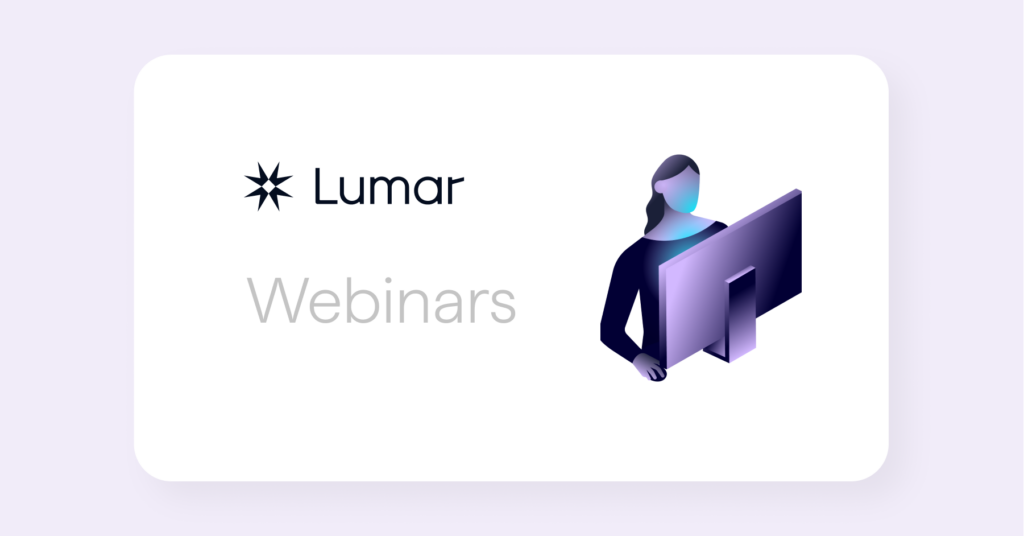For our latest DeepCrawl webinar, we were very excited to welcome Becky Simms, Founder and CEO at Reflect Digital. Joining our host, DeepCrawl’s CAB Chairman, Jon Myers, Becky shared a new way to look at creating content, to compliment your existing strategy and work in harmony with your SEO efforts. She also covered how to consider audience motivations and uncover targeted language and trends to inspire website visitors to take action once on your site.
We’d like to say a big thank you to Becky for her great presentation and for taking the time to share her knowledge and experience with us, as well as to Jon for hosting, and all those who attended.
You can watch the full recording here:
And review the slides here:
Putting content and users heart of every strategy
While content should be at the heart of your SEO strategy, it’s also important to ensure your audience is also there. The most important thing to remember about our audience is that they are humans, and whether your website is B2B or B2C, there is always a human at the end of your marketing message.
In a world where focus is heavily placed on ensuring a website is accessible for search engines, this human focus can sometimes be lost. Becky introduced her talk with an impactful question: ‘how often do you really put the human lens on your content?’ Does your content provide answers to your audience’s questions, spark interest & action and ultimately provide what they expect of it?
The introduction of BERT
As most SEO’s are aware, at the end of last year Google introduced their most important update in the last 5 years, BERT, and this update has given us the gift of human content.
BERT stands for Bidirectional Encoder Representations from Transformers and is used to help improve how Google is able to understand language, and the context of words used in a search. As humans, we are able to understand the context of where a word fits in a sentence and what it means to that sentence, but this is much harder for machines to do, and something Google struggled with before the introduction of BERT. This update is also important for voice search and provides a massive step forward for them to fully understand nuanced user searches.
So far BERT has been used in 1 in 10 of all searches and helps us as users to search in a more natural way, while also helping Google provide more relevant results. This also allows marketers to become more human with their content and think less about keywords.
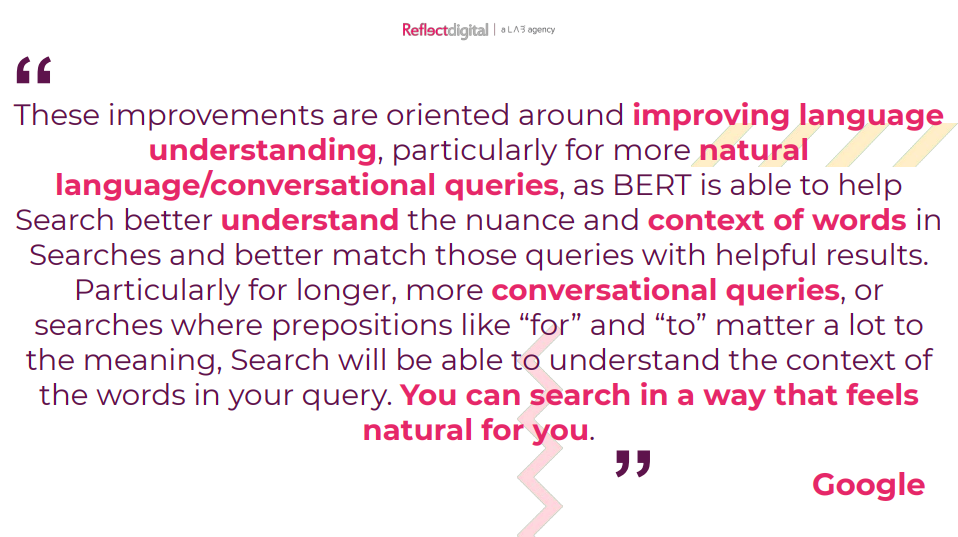
How does BERT work?
The meaning of a word changes depending on the context of a sentence, and Becky shared some interesting examples of this in practice. BERT allows Google to understand the different meanings of these words depending on the sentence it is included within and the words around it.
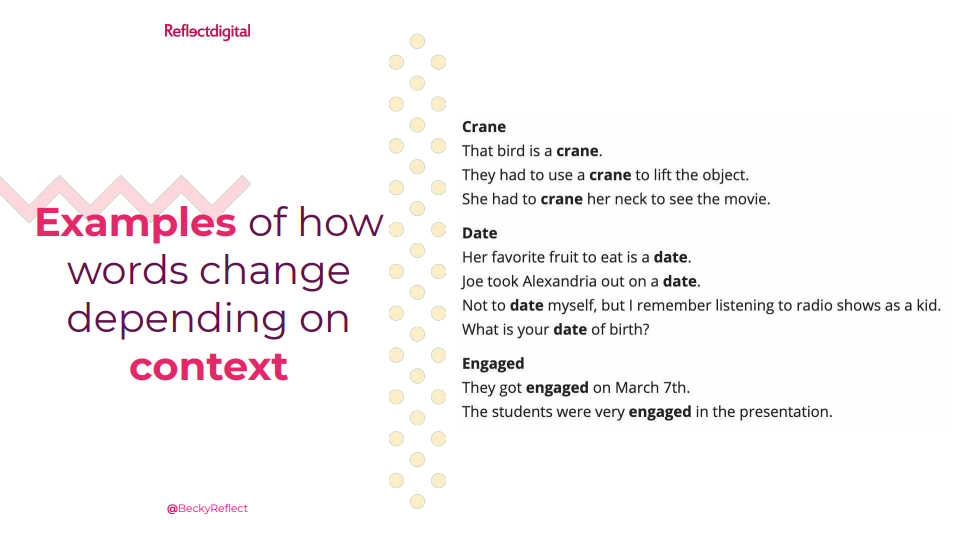
Becky also shared an example of how a search result has changed due to BERT being used to better understand the searchers’ intent and therefore provide a much more meaningful and relevant result.
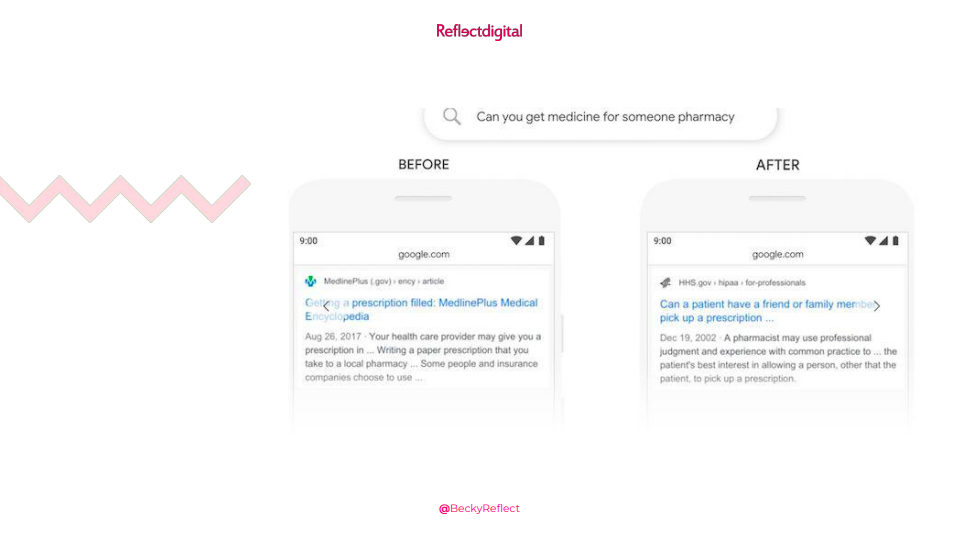
Focusing on the human behind the search phrase
While there are many tools available to help us understand the data behind keywords, including search volume and search trends, it’s just as important to understand who is actually sitting behind these searches.
It’s very easy to get wrapped up in algorithms, updates and chasing ranking positions that we forget that to be truly good as SEOs our job is to provide a good experience and spark action from users.
How well do you know your audience?
An important question to ask yourself is, ‘how well do I know my audience?’ While we may know demographics such as their age, location, salary bracket and family status, these can often be misleading, as everyone is different.
Taking a human focus to content
By not shifting your focus to become more user-centric, you are failing your audience. Economists have discovered that people don’t always respond predictably or rationally to things such as price and value, while neuroscientists have also deduced that all decisions we make are weighed up emotionally, even the logical ones.
However, digital marketing has become so measurable, and this comes at the expense of human-focused content.
Adding a new step to your SEO process
The typical SEO process when working with a new website starts by defining the market they are in, followed by breaking this down and defining the different audiences. The next step is to perform keyword research to understand what the audience is searching for, and what we need to optimise for. Following this, we will map the keywords to the different stages of the sales funnel based on intent.
From here Becky recommends adding an additional step, uncovering audience motivations, in order to understand what drives users to visit your site and ultimately perform the desired action.
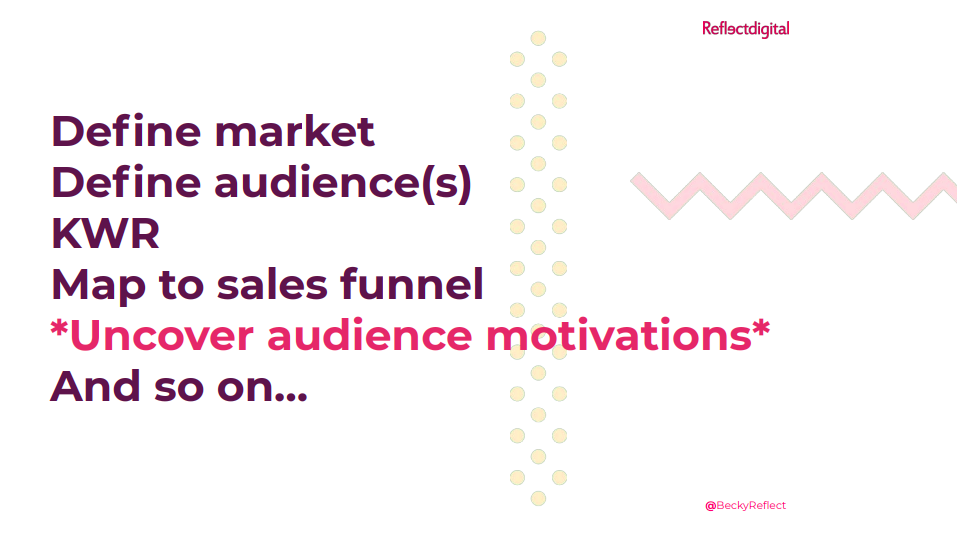
A unique persona model
At Reflect Digital, Becky’s team uses a unique persona model called ‘Monkey Lion Dog’. This model is based on 5 different psychology theories that help to understand audience motivation.
- Monkey – The need to understand context and where you sit in the world.
- Lion – The rational side of our brains, where we weigh things up and understand benefits and details.
- Dog – This represents our feelings and emotions, including the desire to feel connected.
Using this model as we uncover our audience demographics, we are also able to understand the motivations of our audience. This allows us to ensure our content, and messaging, matches exactly what they are looking for.
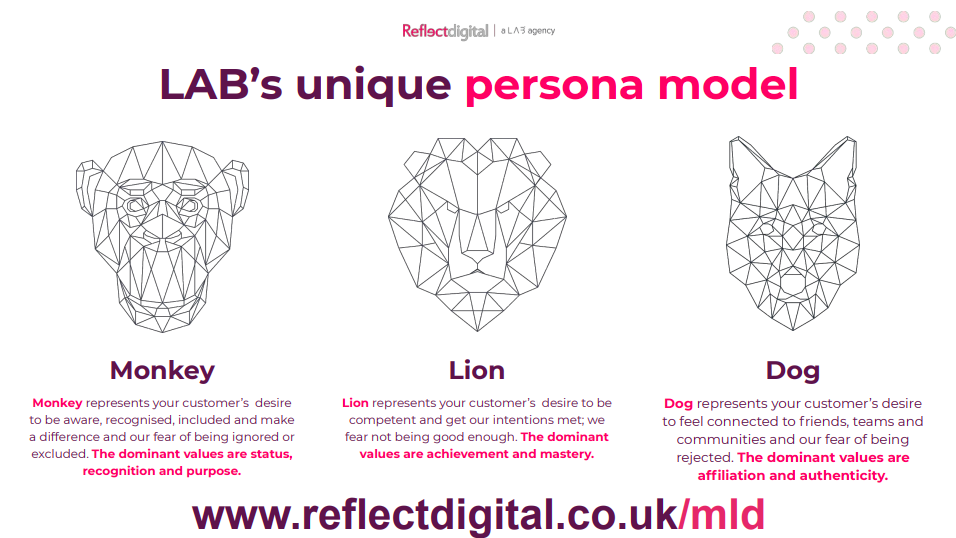
The impact of human focused content
As marketers, it’s important to understand the impact that producing more human-focused content will have on our website and business and Becky shared a couple of examples of this;
- Improving rankings – We know Google is beginning to care a lot more about user-friendly content, so by producing this it will help with rankings.
- Increased conversions – This involves improving how we connect with our audience and provide a journey which is going to allow them to find what they are looking for and ultimately drive an increase in conversions.
Speaking our audience’s language
In order to speak our audience’s language, we need to listen to what they are saying. Becky explained that her team uses an analysis called Comparative Linguistic Analysis (CLA) which allows them to take two different sets of language-based unstructured data and perform comparisons. Becky shared some examples of this, where they have compared the trends pre and during COVID-19, using Twitter data from January and March-June. Their report concluded that;
- We have a lot less to look forward to, for example in January users were 4.5 times more likely to say they couldn’t wait to get paid, or were looking forward to a holiday or important date in the future. This has led to a higher demand for the desire of instant gratification and an increase in online shopping.
- Users are also speaking in a more ‘final type context’ for example saying things such as ‘I will never’.
- The phrase ‘customer service’ has been mentioned 1,252x more during lockdown than before.

This allows us to understand the trends of our users, to discover what they are specifically talking about and searching for. Using CLA we can compare any unstructured language data, pull it together and compare it. This comparison can be done in a number of different ways, for example, based on location or demographics, as well as time.
The purpose of all of this analysis is to drive more relevancy by understanding the language that our audience is speaking and reviewing what they are talking about, and searching for on a mass scale.
Neuro-driven Content
Becky covered 4 different types of language which can be used to help understand neuro-driven content; uninspiring language, self-obsessed & selfless language, static & dynamic language and visual, auditory & kinesthetic language.
Uninspiring language
Language which is not descriptive or engaging is considered uninspiring. Instead, we need to ensure our content is sticky, and to do that it needs to be memorable and evoke emotion.
Self obsessed vs selfless language
In order to provide selfless language, you need to ensure your content is ‘outside in’ instead of ‘inside out’, starting with the customer’s needs first. This allows us to engage our customers more, by addressing the problem that needs to be solved and explaining how your product or service can help with this.
Static vs dynamic language
Content written in the present tense and more detailed based is considered static language, while dynamic language involves looking at impact and considers the future. It’s important to have a balance between these two types of language and finding the right fit for your audience. This is because each individual will gravitate towards one more than the other, depending on what is most important to them at the time of reading.
Visual, auditory and kinesthetic language
Visual language involves things such as “I see what you mean”, auditory language covers things such as “I hear what you are saying”, while kinesthetic language includes “It feels to me like”. Each individual will have a bias as to which language type they prefer, so it’s important to be aware of what our bias is and work towards ensuring our content is not based around this. Instead, it should be across the three different types, allowing our content to be more inclusive and engaging for everyone.
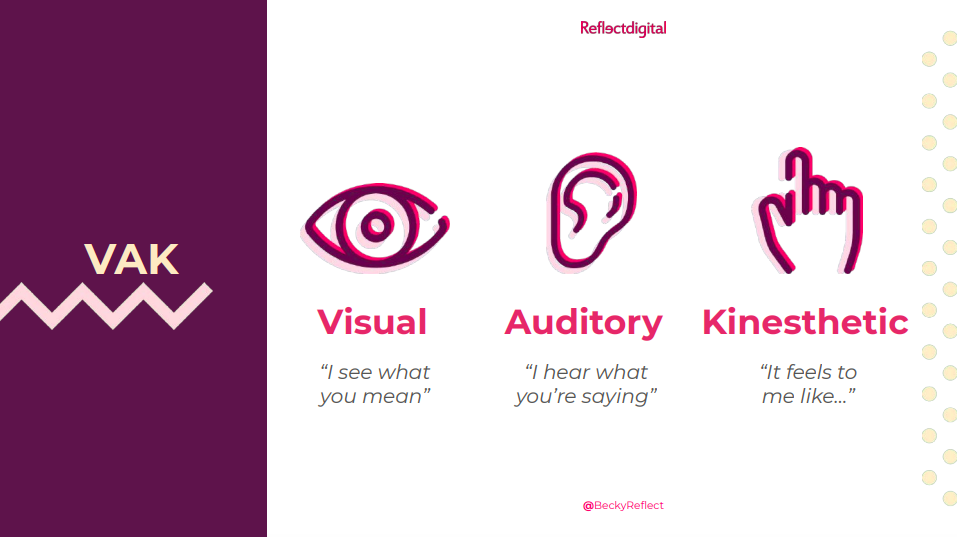
The idea around understanding these different language types is to help us learn to master content that sparks emotion and most importantly action.
Rate your content
Becky also shared a website that her team built last year, called ratemycontent.co.uk. This takes the language types discussed above and gives your content a score based on each. The first score looks at the words which are being used and how engaging they are, followed by a score depending on how static or dynamic your content is. The next result will represent how selfish or selfless your content is considered and finally there is a scale for how visual, auditory and kinesthetic your content is.
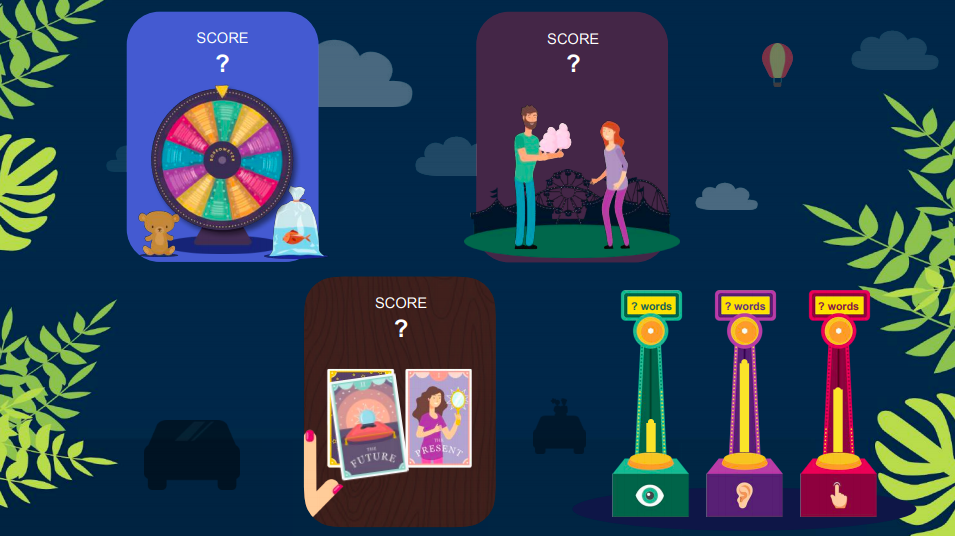
Reflect digital has had a number of sites run their content through this tool, and have extracted some useful insights, which Becky shared with us.
B2B Content
- 45% of B2B content scored a boring score.
- Only 13% achieved an engaging score.
- 70% of B2B content was static.
- 40% of B2B content was selfish and was not putting the customer first.
B2C Content
- In comparison to B2B content, B2C content scored an even higher boring score of 52%
While 82% of B2C content was static. - 48% of B2C content was considered selfish.
Tips to make your content more human
Becky also shared her top 9 tips for making content more human;
- Be more descriptive and fun – play around with the language that you use, as humans find this much more engaging to read.
- Think about bringing emotion to your content – consider the feelings your product or service evokes and use this to make your content more memorable.
- Consider your audience’s challenges first before broadcasting what you do, by being outside in rather than inside out.
- Think about context rather than just explaining the features – consider the impact of your product or service.
- Consider how you can include more visual, auditory and kinesthetic language throughout your content.
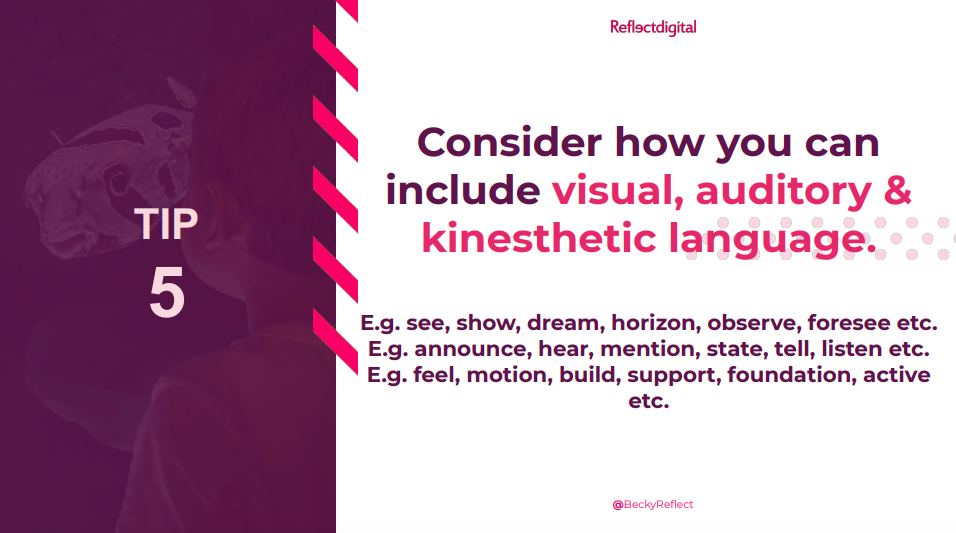
- Remember that Google understands context more than ever before – it’s therefore important to have a balance between human first content and other additional ranking signals.
- Think about how you can get closer to your audience’s language – consider how you can understand and reflect their choice of language within your content.
- Think about how you can use intrinsic motivations to attract your audience’s attention and draw them in.
- Remember that through content you have the power to affect your user’s behavior.

Get started with DeepCrawl
If you’re interested in learning about how DeepCrawl can help you to identify technical and content issues on your site which are impacting both search engines and users, why not get started with a DeepCrawl account today.
Discover DeepCrawl Automator
DeepCrawl Automator is a one of a kind product that helps to avoid traffic and revenue loss by mitigating the risk of introducing harmful code changes with new releases. Automator benefits the whole company by preventing errors from being released, speeding up development and QA processes and reducing the impact on production environments.
